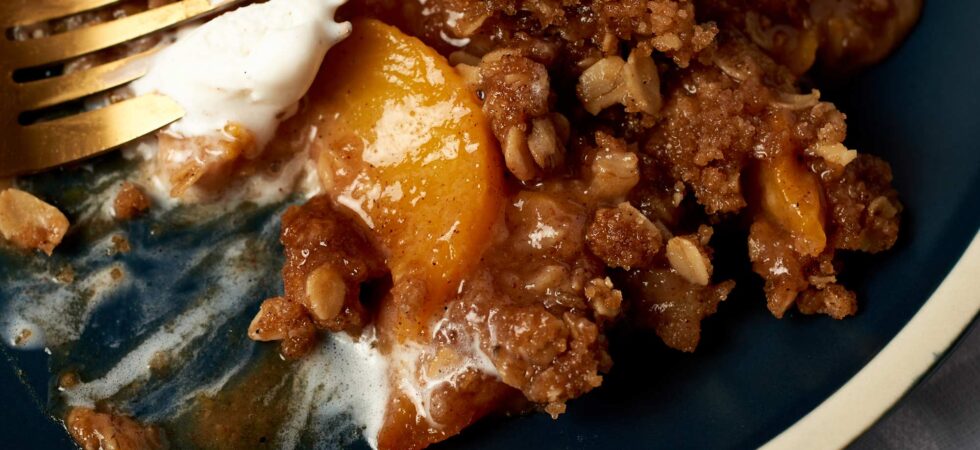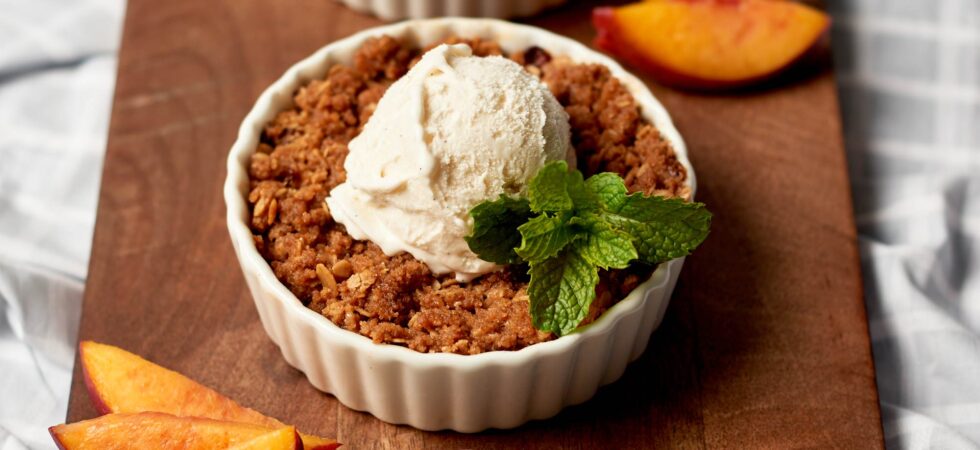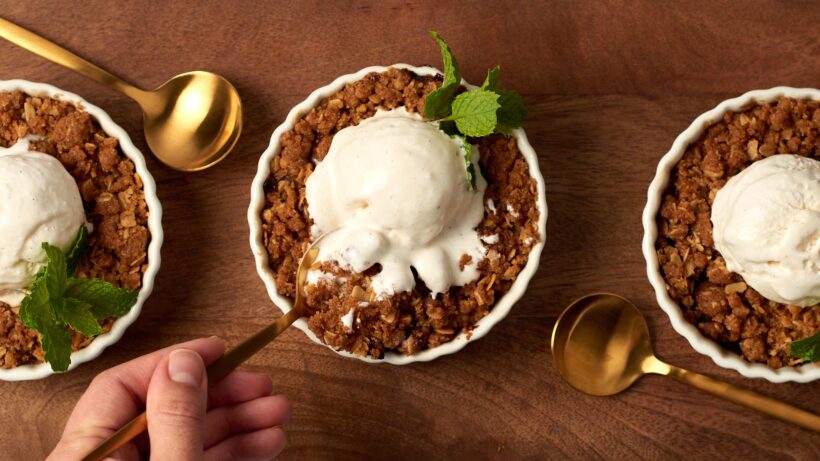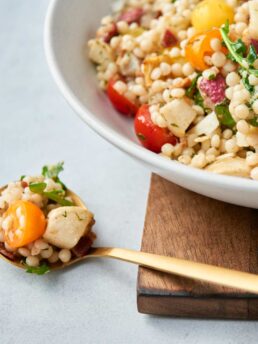Nectarine Crisp with Cinnamon-Oat Topping

This traditional nectarine crisp with cinnamon-oat topping, checks all of my summer dessert boxes: Stone fruit filling, check; a crispy, crunchy cinnamon-spiced topping, check; and a 50:50 ratio of filling to topping, check!
If you ever want to get me on my soapbox, ask me about the crust/bread/topping to filling ratio in foods like pies (even savory ones), filled pastries, crisps, and crumbles. I am here for ample amounts of crunchy, flakey, buttery goodness amid bursts of tart or umami flavor.
To me, there is such a thing as too much filling. I don’t like dishes of soupy fruit or stew with a topping that goes soggy after sitting for longer than an hour; nor do I enjoy mainlining pastry cream in every bite of dessert.
I know not everyone feels the same way, but if you find yourself agreeing, this nectarine crisp is the one for you!

Get the Recipe: Nectarine Crisp with Cinnamon Oat Topping
Ingredients
Cinnamon-Oat Topping
- 1½ cups brown sugar, packed
- ½ cup granulated sugar
- 1½ cups old-fashioned oats
- 1½ cups all-purpose flour
- 1 tablespoon ground cinnamon
- 1 teaspoon fresh grated nutmeg
- 1/2 teaspoon ground cloves
- 1 teaspoon Diamond Crystal kosher salt
- 1 cup (2 sticks) unsalted, high-fat (European-style) butter, (vegans see FAQs)
Nectarine Filling
- ¼ cup brown sugar, packed
- 2 tablespoons granulated sugar
- ¼ cup all-purpose flour
- 1 teaspoon ground cinnamon
- ½ teaspoon Diamond Crystal kosher salt
- ½ teaspoon lemon zest, (½ a lemon)
- 3 pounds nectarines, sliced, (about 9-10 nectarines)
- 1 tablespoon cornstarch
- 2 tablespoons fresh lemon juice, (about ½ lemon)
Equipment
- measuring Cups
- Measuring spoons
- kitchen scale
- 2 large bowls
- 1 small bowl
- 1 slotted spoon or spider optional (for blanching & peeling)
- 1 2.5-3qt (2.3-2.8L) medium sauce pot optional (for blanching & peeling)
- 1 medium bowl optional (for blanching & peeling)
- 1 paring knife
- 1 cutting board
- 1 large serving spoon or spatula
- 1 2.5-3qt (2.3-2.8L) baking dish typically 8x11in (20x28cm)
- 1 half-sheet baking tray
Instructions
- To start, preheat your oven to 450°F (232°C). Then, lightly butter your baking dish and set it aside.
- Next, measure out all of the topping ingredients. Combine everything except for the butter and mix well. Then, cut the butter into 1/2in (1.3cm) cubes. Add the butter pieces into the bowl of topping mix and combine with your hands by smushing and rubbing the butter into the dry ingredients. Stop when no dry ingredients remain unincorporated and the blend forms clumps between bean and pea-sized pieces. Don't overmix. If the topping is too uniform, the mix won't dry out correctly while baking. Place the topping in the refrigerator to chill while you make the filling.
- For the filling, whisk together the following filling ingredients into a large bowl: brown sugar; granulated sugar; flour; cinnamon; salt; and zest. Set the bowl aside. Next, De-pit and slice your nectarines into ½-1in (1.3-2.5cm) thick wedges (see FAQs for help). Then, add them to your dry filling mix and gently toss to coat with a large spoon. In a small bowl, make a cornstarch slurry by whisking the lemon juice and cornstarch together. Pour the slurry over the coated nectarines and gently toss once more.
- To assemble, add the filling to your buttered baking dish. Then, take the topping out of the fridge and cover the nectarines with half of the mixture. Set aside the remaining topping.
- Now, place the dish on a baking sheet (in case of spillage) and put the crisp into the middle rack of your oven. Immediately reduce the oven temperature to 350°F (177°C). Bake the crisp for 30 minutes. Then, take it out, add the rest of the crisp topping, and bake for another 30 minutes. Let the crisp cool and set for 15 minutes before serving.
Notes
- Substitute peaches for the nectarines in a 1:1 ratio.
- I like to the leave the skin on the nectarines, because it imparts a beautiful burgundy color, additional pectin, and more flavor to the crisp. If skin-on is not for you, blanch the fruit and peel them. (See FAQs if you’d like instructions on blanching and slicing your fruit.)
- Store the crisp in your refrigerator for up to 5 days or freezer for up to 2 months.
- For all my gluten free friends, this is finally a recipe where I’m comfortable giving gluten free substitutions! (See FAQs for measurements and instructions)
- If you want to add chopped nuts or slivered almonds to the topping for additional crunch, go for it! For more even more variety, consider adding other berries or even herbs like basil or thyme to the filling.
Nutrition

Frequently Asked Questions
There are a few ways to customize this crisp even further:
1. Change out the fruits in the filling: Any stone fruit can be exchanged for the nectarines. You should consider using peaches, apricots, plums, and even cherries. You can also use a mix of berries and stone fruits, like nectarines and blueberries or plums and blackberries. Or go crazy and use mango.
If you plan to use different fruit or a combination of fruits, think about their liquid and pectin content before you make the filling. Apricots have more pectin than nectarines and cherries have less. So, add up to 1 tbsp (6g) of cornstarch in a cherry filling and consider lowering the amount of flour in the apricot filling. I don’t suggest leaving out cornstarch altogether. It helps to gel and set the filling.
2. Add herbs to the filling or topping: Adding herbs is a really fun way to modernize a crisp. They should be chopped quite small and added to either the topping or filling. I suggest adding sturdier herbs (thyme, rosemary, and sage) to the topping, because they won’t turn black or burn while baking. You can add herbs like basil and mint to the filling.
3. Add nuts to the topping: Crisp toppings can also have nuts in them. This one doesn’t, but that doesn’t mean it can’t. Traditionally, the nuts used in crisps are almonds, but pistachios would be fantastic in this application as well. Add up to ¾ cup (115-135g) of chopped or sliced nuts to the topping mix.
So, you don’t want the skin on your stone fruit? Let’s fix that by blanching them!
Bring a pot of water to a low boil on the stove and place the fruit in using a slotted spoon. Let them cook for 90 seconds and then transfer them to an ice bath. After the fruit cools (about 3 minutes), slice and then peel them. Depending on the type of stone fruit you are using this might go a few different ways:
1. Free-stone peaches and nectarines: Press a paring knife through the flesh of the fruit until you hit the pit and then rotate the knife all of the way around, top to bottom. You should be separating the fruit into east and west hemispheres. Place your hands on either side, then, twist and pull the halves away from the pit. Next, peel the skin from the fruit. Lay them cut (flat) side down and slice each side into ½-1in (1.3-2.5cm) thick wedges.
2. Non-freestone peaches and nectarines: We have two options here depending on how ripe the fruit is…
– A. If your fruit doesn’t pull easily away from the pit and they aren’t very ripe, then slice them the same way you would an apple. Cut straight down the fruit, alongside the pit, top to bottom on two sides. Then cut off the, now, smaller leftover sides. Peel the sliced pieces and then lay them flat side down on your cutting board. Slice each piece into ½-1in (1.3-2.5cm) thick wedges.
– B. If your fruit doesn’t pull easily away from the pit and is ripe enough to bruise easy, then use a similar tactic as the free-stone peaches. Press a paring knife through the flesh of the fruit until you hit the pit and then rotate the knife all of the way around, top to bottom (sometimes this splits the fruit in half, including the pit. Don’t panic.). Now, cut ½-1in (1.3-2.5cm) wedges into the peach and use the knife or your fingers to remove one piece at a time. If you are still having trouble, take off 1-2 pieces, until you can cut down along the pit, separating it from the flesh.
Once sliced and peeled, continue with the recipe as written.
OF NOTE: If you plan to peel your stone fruit, I recommend cutting until you’ve created a flat surface and THEN peeling them. Peeling the blanched fruit makes them very slippery and it’s not the safest situation. Please be safe, rather than sorry.
Yep! If you plan to use frozen fruit, just make sure to do two things:
1. Use 1-1½ tablespoons (6-9g) of cornstarch in the filling. The freezing process expands the liquid in the fruits’ cells and may damage some of the fruits’ cellular structure. This means they will break down a bit more than fresh fruit and you’ll need a little extra cornstarch for the same filling viscosity.
2. Take the fruit fright from the freezer to the filling bowl and then the oven. Don’t defrost the pieces first.
If you really want to defrost the fruit that’s also an option, but it adds a few steps and considerations.
1. Defrost the fruit in the refrigerator overnight.
2. Drain and pat away any excess moisture.
3. Add 1 tablespoon (6g) of cornstarch to the filling slurry. You can probably get away with this amount, since you’ve reduced the moisture content.
OF NOTE: Defrosted fruit will not hold a much shape as frozen fruit when it’s baked. So, even though you won’t need as much cornstarch, the textures will differ. When baked, frozen fruit is closer in texture to fresh fruit than frozen and defrosted fruit.
No problem here either!
The heat, sugar, and lemon juice (acid) in the filling will soften the nectarine slices right up while they are baking. The only thing to consider with fruit that isn’t fully ripe is their flavor. They won’t be as strong in flavor, and they will be considerably more tart than ripe fruit. If pops of tart filling don’t appeal to you, try adding a 1tsp (5ml) of vanilla and up to 2 extra tablespoons (30g) of dark brown sugar to the filling, in anticipation of the needed extra sweetener.
If you don’t want to experiment with extra ingredients, try speeding ripening along. You can use the same tactic from my overnight banana bread recipe. Place the nectarines into a bag with other ethylene producing fruit like apples and bananas and they should soften in 1-2 days.
You sure CAN! 🙂
TLDR:
– For the filling: replace the all-purpose flour with a 1:1 gluten free baking mix. (I used Bob’s Red Mill 1:1 Gluten Free Baking Flour)
– For the topping: replace the all-purpose flour with equal parts 1:1 GF baking flour (1/2c or 70g), corn flour (2/3c or 70g), and almond flour (2/3c or 70g).
Full Explanation:
I felt badly that a lot of my recipes with gluten are full-blown bread and pastry recipes, so I developed a gluten free (GF) version for this one.
Initially I just used the 1:1 GF Flour and it only half worked. The filling set wonderfully, but the topping never crisped up and mostly melted into the filling. I actually had Patreon members comment that it looked like “chili gone wrong” or “really delicious oatmeal”, if that’s a helpful visual. (LOL)
So, I stepped back and considered what the flour in this recipe is meant to provide. For the filling, the flour gels and helps create a thicker bodied, richer sauce. CHECK! And, for the topping, the flour is there to bind the other ingredients together and get, well, crisp. But it’s also there to absorb moisture from the filling, so the first half of the topping can act as a moisture barrier for the second half. PARTIAL CHECK!
The GF Flour did a great job binding the topping ingredients together pre-baking, but it’s mostly a mixture of starchy substances (e.g. rice flour, potato starch, tapioca flour and xanthan gum). So, it disintegrated when the nectarines released their moisture. This is where the 1:1 GF Baking Flour failed me.
To combat this, I knew I needed to add in sturdier flours; enter corn flour and almond flour. Corn flour is a super-absorber, but I didn’t want the topping to taste too much of corn, so I also added almond flour to temper the flavor and still provide structure. This time I used equal parts of the 1:1 GF Baking Flour (for binding), corn flour (for absorption), and almond flour (for structure and flavor). And I totaled their combined weight to roughly a 1:1 substitution for the original topping’s all-purpose flour. (See TLDR for measurements)
Because only the butter in this recipe marks it as NOT vegan, substituting a vegan butter for the regular butter is an easy fix.
If you’re looking for a good vegan butter, I suggest using Miyoko’s European Style Vegan Butter. It contains cashew milk solids, which provide a richness similar to dairy butter. And it’s great for browned butter too!
It doesn’t! Yay! Tempered glass, metal, enameled-cast iron, etc. are all welcome here.
The only thing to consider is the thinness of metal. The filling that bubbles up through the topping during baking, might burn a bit to the sides of the container.
I like to cover my crisps with a lid, if the baking dish came with one, or cling film, if it didn’t and keep the whole thing in the same vessel it was baked in.
If kept refrigerated, it will last just fine for 4-5 days. I don’t really recommend freezing a crisp before baking, for textural purposes, but you can freeze the whole thing right after it fully cools. Keep the crisp frozen for up to 2 months.
Reheat this…or don’t. I fully eat this crisp cold, straight from the refrigerator. No judgement here!
If you want to reheat your nectarine crisp with cinnamon-oat topping, just warm it through in the microwave in 15-30 second increments or put the dish back in the oven to bake at 300°F (149°C) for 10 minutes (if it’s coming from the refrigerator) and 20 minutes (If it’s coming from the freezer). Re-heating is mostly about warming up the dessert rather than crisping up the topping. That part of the dish stays relatively dry as long as it isn’t covered before it has had a chance to fully cool.
OATS! When you add oats and (sometimes) other mix-ins, like dried fruit and nuts, to a crumble topping it then becomes a crisp topping. “The more you know!”
Oh, fun question! Here are the differences as I know them:
– Crisp: A crisp has a fruit filling topped with a crispy mixture of flour, butter, sugar, oats, and (sometimes) nuts. The topping of a crisp is characterized by its larger, more defined clusters of crumbs.
– Crumble: A crumble features the same fruit filling and a topping that is quite similar to a crisp topping. The difference? It does not have oats, so it still makes a crust, but doesn’t have the same signature clusters and texture. It reminds me of a thicker and crispier streusel topping.
– Cobbler: A cobbler is the combination of fruit filling topped with a dough or thick batter that bakes into a scone or American biscuit-like topping. The topping is spooned or dolloped over the fruit and resembles cobblestone streets. Get it? “Cobbler”
– Buckle: A buckle has the same topping as a crisp, but it’s base is cake with fruit folded in. The cake batter rises up around the fruit, which may cause the surface to “buckle”. So, the textural difference comes from the soft cake, the cooked fruit, and a crispy top. Not a semi-set filling and crispy top like the other desserts in this list.



